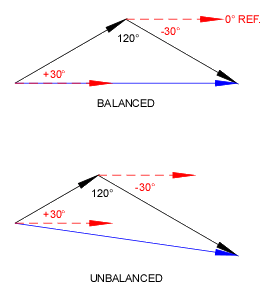How does everyone do load calculations for a 240V high leg service?
I divide the loads up per phase. All the 120V loads go on phase A. Then I put the 240V line-line loads on phases B and C. (For example, a 240V single phase air conditioner at 13 amps would be 3120VA on phase B. If I have 2 of these AC's, I would put the other one on phase C.)
Then I add up the KVA on each phase and divide by 240 volts to get the phase currents. To get the line currents, I take the square root of the sum of the squares of phase A and phase B currents.
For example, assume there is 48KVA on phase A, 24KVA on phase B, and 20KVA on phase C. To find the largest line current, I would take the 48KVA and the 24KVA to get 200A and 100A. Then sqrt(200^2+100^2) = 223 amps.
So in theory, this load could be ran from a 225A feeder. Does all that sound correct, or does anyone see any errors in my calculations?
Thanks:
Steve
I divide the loads up per phase. All the 120V loads go on phase A. Then I put the 240V line-line loads on phases B and C. (For example, a 240V single phase air conditioner at 13 amps would be 3120VA on phase B. If I have 2 of these AC's, I would put the other one on phase C.)
Then I add up the KVA on each phase and divide by 240 volts to get the phase currents. To get the line currents, I take the square root of the sum of the squares of phase A and phase B currents.
For example, assume there is 48KVA on phase A, 24KVA on phase B, and 20KVA on phase C. To find the largest line current, I would take the 48KVA and the 24KVA to get 200A and 100A. Then sqrt(200^2+100^2) = 223 amps.
So in theory, this load could be ran from a 225A feeder. Does all that sound correct, or does anyone see any errors in my calculations?
Thanks:
Steve



